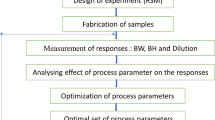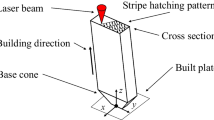Abstract
A new geometrical parameter, lambda (λ) angle, was introduced in the equal-channel angular pressing (ECAP) process. The clockwise angle between the theoretical shear plane and the punch/billet interface was defined as λ. Microhardness homogeneity was increased employing λ = 90° compared to the conventional technique with the horizontal punch tip (λ = 45°). The main reason was reducing the width of the plastic deformation zone (PDZ) and occurring the deformation in the immediate vicinity of the shear plane. The imposed shear strain became uniform by decreasing the width of PDZ, leading to homogeneous microstructure and properties. In addition, microstructural assessment showed that the second phase particles and constitutive elements were uniformly distributed in case of λ = 90°. More uniform microstructure was also achieved in this case. Furthermore, tensile tests showed that ductility of the billets after one and two ECAP passes using λ = 90° was increased by around 36 and 21 %, respectively.










Similar content being viewed by others
References
Valiev RZ, Langdon TG (2006) Principles of equal-channel angular pressing as a processing tool for grain refinement. Prog Mater Sci 51(7):881–981
Iwahashi Y, Wang J, Horita Z, Nemoto M, Langdon TG (1996) Principle of equal-channel angular pressing for the processing of ultra-fine grained materials. Scr Mater 35(2):143–146
Nakashima K, Horita Z, Nemoto M, Langdon TG (1998) Influence of channel angle on the development of ultrafine grains in equal-channel angular pressing. Acta Mater 46(5):1589–1599
Duan ZC, Langdon TG (2011) An experimental evaluation of a special ECAP die containing two equal arcs of curvature. Mater Sci Eng A 528(12):4173–4179
Berbon P, Furukawa M, Horita Z, Nemoto M, Langdon T (1999) Influence of pressing speed on microstructural development in equal-channel angular pressing. Metall Mater Trans A 30(8):1989–1997
Yamashita A, Yamaguchi D, Horita Z, Langdon TG (2000) Influence of pressing temperature on microstructural development in equal-channel angular pressing. Mater Sci Eng A 287(1):100–106
Lapovok RY (2005) The role of back-pressure in equal channel angular extrusion. J Mater Sci 40(2):341–346. doi:10.1007/s10853-005-6088-0
Segal VM (2004) Engineering and commercialization of equal channel angular extrusion (ECAE). Mater Sci Eng, A 386(1–2):269–276
Shokuhfar A, Nejadseyfi O (2014) The influence of friction on the processing of ultrafine-grained/nanostructured materials by equal-channel angular pressing. J Mater Eng Perform 23(3):1038–1048
Oruganti RK, Subramanian PR, Marte JS, Gigliotti MF, Amancherla S (2005) Effect of friction, backpressure and strain rate sensitivity on material flow during equal channel angular extrusion. Mater Sci Eng A 406(1–2):102–109
Raab GI (2005) Plastic flow at equal channel angular processing in parallel channels. Mater Sci Eng A 410–411:230–233
Patil Basavaraj V, Chakkingal U, Prasanna Kumar TS (2009) Study of channel angle influence on material flow and strain inhomogeneity in equal channel angular pressing using 3D finite element simulation. J Mater Process Technol 209(1):89–95
Dumoulin S, Roven HJ, Werenskiold JC, Valberg HS (2005) Finite element modeling of equal channel angular pressing: Effect of material properties, friction and die geometry. Mater Sci Eng A 410–411:248–251
Kocich R, Fiala J, Szurman I, Macháčková A, Mihola M (2011) Twist-channel angular pressing: effect of the strain path on grain refinement and mechanical properties of copper. J Mater Sci 46(24):7865–7876. doi:10.1007/s10853-011-5768-1
Shamsborhan M, Shokuhfar A (2014) A planar twist channel angular extrusion (PTCAE) as a novel severe plastic deformation method based on equal channel angular extrusion (ECAE) method. Proc Inst Mech Eng 228(12):2246–2250
Figueiredo RB, Langdon TG (2009) Strategies for achieving high strain rate superplasticity in magnesium alloys processed by equal-channel angular pressing. Scr Mater 61(1):84–87
Xu C, Langdon T, Horita Z, Furukawa M (2004) Using equal-channel angular pressing for the production of superplastic aluminum and magnesium alloys. J Mater Eng Perform 13(6):683–690
Figueiredo RB, Langdon TG (2008) Record superplastic ductility in a magnesium alloy processed by equal-channel angular pressing. Adv Eng Mater 10(1–2):37–40
Petruška J, Janíček L (2003) On the evaluation of strain inhomogeneity by hardness measurement of formed products. J Mater Process Technol 143–144:300–305
Prell M, Xu C, Langdon TG (2008) The evolution of homogeneity on longitudinal sections during processing by ECAP. Mater Sci Eng A 480(1–2):449–455
Kawasaki M, Figueiredo R, Huang Y, Langdon T (2014) Interpretation of hardness evolution in metals processed by high-pressure torsion. J Mater Sci 49(19):6586–6596. doi:10.1007/s10853-014-8262-8
Xu C, Langdon T (2007) The development of hardness homogeneity in aluminum and an aluminum alloy processed by ECAP. J Mater Sci 42(5):1542–1550. doi:10.1007/s10853-006-0899-5
Kawasaki M, Figueiredo RB, Langdon TG (2011) An investigation of hardness homogeneity throughout disks processed by high-pressure torsion. Acta Mater 59(1):308–316
Segal VM (1995) Materials processing by simple shear. Mater Sci Eng A 197(2):157–164
Yoon SC, Kim HS (2008) Finite element analysis of the effect of the inner corner angle in equal channel angular pressing. Mater Sci Eng A 490(1–2):438–444
Nagasekhar AV, Tick-Hon Y, Seow HP (2007) Deformation behavior and strain homogeneity in equal channel angular extrusion/pressing. J Mater Process Technol 192–193:449–452
Tóth LS, Arruffat Massion R, Germain L, Baik SC, Suwas S (2004) Analysis of texture evolution in equal channel angular extrusion of copper using a new flow field. Acta Mater 52(7):1885–1898
Reihanian M, Ebrahimi R, Moshksar MM (2009) Upper-bound analysis of equal channel angular extrusion using linear and rotational velocity fields. Mater Des 30(1):28–34
Narooei K, Karimi Taheri A (2010) A new model for prediction the strain field and extrusion pressure in ECAE process of circular cross section. Appl Math Model 34(7):1901–1917
Kim H, Lee S-M, Altan T (1996) Prediction of hardness distribution in cold backward extruded cups. J Mater Process Technol 59(1–2):113–121
Li S, Bourke MAM, Beyerlein IJ, Alexander DJ, Clausen B (2004) Finite element analysis of the plastic deformation zone and working load in equal channel angular extrusion. Mater Sci Eng A 382(1–2):217–236
Yoon SC, Seo MH, Kim HS (2006) Preform effect on the plastic deformation behavior of workpieces in equal channel angular pressing. Scr Mater 55(2):159–162
Shokuhfar A, Nejadseyfi O (2014) A comparison of the effects of severe plastic deformation and heat treatment on the tensile properties and impact toughness of aluminum alloy 6061. Mater Sci Eng A 594:140–148
Xu C, Xia K, Langdon TG (2009) Processing of a magnesium alloy by equal-channel angular pressing using a back-pressure. Mater Sci Eng A 527(1–2):205–211
Xu C, Xia K, Langdon TG (2007) The role of back pressure in the processing of pure aluminum by equal-channel angular pressing. Acta Mater 55(7):2351–2360
Kim HS, Seo MH, Hong SI (2000) On the die corner gap formation in equal channel angular pressing. Mater Sci Eng A 291(1–2):86–90
Segal VM (2003) Slip line solutions, deformation mode and loading history during equal channel angular extrusion. Mater Sci Eng A 345(1–2):36–46
Lapovok R, Estrin Y, Popov MV, Rundell S, Williams T (2008) Enhanced superplasticity of magnesium alloy AZ31 obtained through equal-channel angular pressing with back-pressure. J Mater Sci 43(23–24):7372–7378. doi:10.1007/s10853-008-2685-z
Kawasaki M, Langdon T (2007) Principles of superplasticity in ultrafine-grained materials. J Mater Sci 42(5):1782–1796. doi:10.1007/s10853-006-0954-2
Acknowledgements
The authors would like to thank K.N. Toosi University of Technology, Tehran, Iran for research facilities used in this work.
Author information
Authors and Affiliations
Corresponding author
Rights and permissions
About this article
Cite this article
Nejadseyfi, O., Shokuhfar, A., Azimi, A. et al. Improving homogeneity of ultrafine-grained/nanostructured materials produced by ECAP using a bevel-edge punch. J Mater Sci 50, 1513–1522 (2015). https://doi.org/10.1007/s10853-014-8712-3
Received:
Accepted:
Published:
Issue Date:
DOI: https://doi.org/10.1007/s10853-014-8712-3




